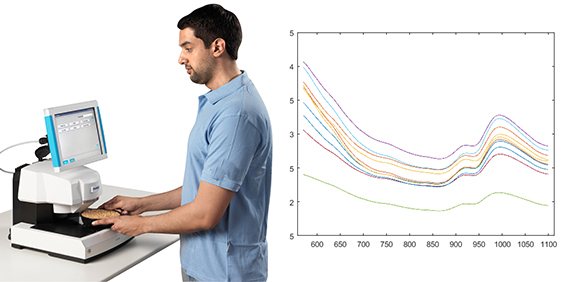5 NIR Spectroscopy Pre-Calibration Techniques for Food Analysis
NIR instruments need to be trained, or calibrated, for the measurements you want to perform. Often instruments come pre-calibrated from the factory, but understanding some basics of NIR calibration techniques can be helpful for users.
NIR is a secondary form of analysis and to calibrate an instrument you need to measure a number of samples both by the NIR instrument you want to use, and a reference method. The data from these measurements is entered into a software which finds the relationship between the infrared information from the samples, and the analysis results from the reference method. This relationship which is called the calibration model, is expressed as an algorithm, or mathematical equation, which the instrument uses to predict measurement results when analyzing unknown samples.
Several mathematical techniques are used to derive these algorithms, ranging from very simple ones to very advanced. There is no calibration technique which is inherently better than others, but rather it depends on the situation.
The techniques explained below are the ones most commonly used.
- MLR (Multiple Linear Regression)
This most basic technique is generally used for filter technology instruments, in simple applications. MLR is suitable only when there is a very strong correlation between the parameter to be measured, and a few specific wavelengths of infrared light. One such situation would be the measurement of moisture variation in a situation when everything else remains stable. Such cases are quite rare, and hence filter technology and MLR are not used much today.TAKE-AWAY: Suitable for very simple applications only. - PLS (Partial Least Squares)
PLS is a much more advanced technique, and the most commonly used calibration technique for all types NIR instruments. It performs well in most situations and it’s often possible to develop good calibrations with as little as 100 samples. Another strength of PLS is that it typically gives reasonable predictions even for samples which are a bit outside of the range that the calibration was developed on.In applications where you would like one calibration to cover a very wide variation of samples PLS doesn’t always give optimal performance. See this article for one such case: developing a general calibration model for all types of meats and meat products. PLS performed very well on each type of meat on its own, but performance wasn’t fully maintained when combining all meat products into one calibration. ANN and HR turned out to perform better in that case.TAKE-AWAY: Suitable for most situations. Limited in some situations when there is a great deal of variation and diversity.
- Local
The Local technique attempts to overcome the limitation of PLS in handling situations with great sample diversity. In Local there isn’t a pre-defined calibration model. Instead there is a database of samples, which includes spectra and reference values. Every time an unknown sample is analyzed, Local evaluates its infrared signal and locates similar samples in the database and quickly calculates a PLS model based on those similar samples.This technique provides the advantage of being able to handle very diverse situations, provided that there are enough samples of each type. Another benefit is that it’s relatively easy to include new variation in a Local model, as new calibration samples can simply be added to the database.However, this technique requires a large number of samples, and the database needs to be included in every instrument. Additionally with Local, there is no real learning as new samples are added, and any unknown sample needs to be similar to what is already in the database for good prediction performance. For traceability purposes it’s also a challenge to document which calibration model was used for a specific analysis, as the model is unique to each analysis and the exact composition of the database at that time.TAKE-AWAY: Suitable for situations where sample variation is great. Requires lots of calibration samples, that adequately characterize future samples. - ANN (Artificial Neural Networks)
The name Artificial Neural Networks may suggest that this is something completely different than other techniques, but ANN is just slightly different mathematics. It has the advantage that one calibration model can cover very different types of samples and yet provide accurate results. It is also able to handle unwanted variation including variation in instrument hardware, temperature or reference method.The biggest drawback is that you need a very large number of samples in your database before ANN starts to deliver; at least 1000 samples and perhaps even 4000-5000 samples for a significant effect. With ANN you also have to take care to include all possible future variation in your model, as ANN is actually less robust than PLS on samples that are different to what the model was developed on.TAKE-AWAY: Suitable for situations where sample variation is great. Requires lots of calibration samples that properly represent future samples. - HR (Honigs Regression)
Honigs Regression is a proprietary technique developed by Perten Instruments. Its intention is to combine the robustness of PLS with the ability of Local/ANN to handle large sample variation, but without requiring thousands of samples. Honigs Regression combines a PLS calibration model with a sample database containing spectra and reference values. The prediction by the PLS calibration model is adjusted based on the properties of the most similar samples found in the database.Honigs Regression typically performs very well in situations where very different types of samples need to be covered by one calibration model. As with Local, it’s easy to update a Honigs Regression model to cover new variation by simply adding samples to the database.TAKE-AWAY: Suitable for situations where sample variation is great.
